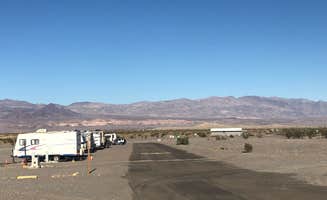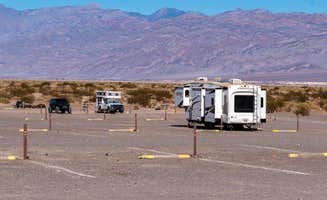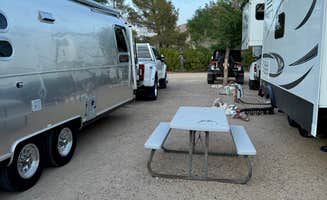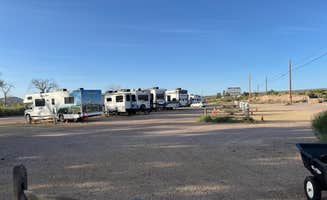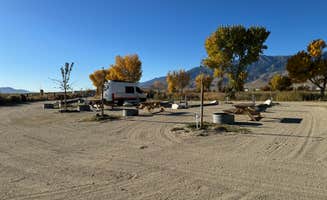Death Valley National Park spans 3.4 million acres across eastern California and Nevada, with elevations ranging from 282 feet below sea level at Badwater Basin to over 11,000 feet at Telescope Peak. Summer temperatures regularly exceed 120°F, making fall through spring the primary camping seasons. Camping options outside the national park boundaries offer alternatives when park campgrounds fill or close due to extreme heat conditions.
What to do
Explore the ghost town of Rhyolite: Located near Beatty, Nevada, this accessible abandoned mining town provides a glimpse into the area's gold rush history. "Beatty, NV was about 20 degrees cooler than Death Valley. If you want to stay out of the valley while visiting this is a great place to do so," notes Nick J. from Space Station RV Park & Market.
Visit Darwin Falls: This desert oasis near Panamint Springs offers a relatively easy half-day hike to a year-round waterfall. "There is plenty of hikes around the area, including the awesome Maryjane Falls close by. The other main stuff is on the opposite side of the park. Still the drive wasn't too long," reports Rose B. who stayed at Panamint Springs Resort.
Photograph night skies: The lack of light pollution creates exceptional stargazing opportunities. "The night we stayed was a new moon, so the dark sky views were INCREDIBLE. We saw the milky way with our bare eyes sitting on the porch of our cabin," writes Les R. about their experience at Panamint Springs Resort.
What campers like
Cooler temperatures outside the valley: Many campers appreciate the temperature differential between Death Valley proper and surrounding areas. "We stayed recently when it was 116 during the day, but since the sites had electric, we gave it a shot," shares Garrett B. from Stovepipe Wells Village RV Park.
Wildlife encounters: The desert ecosystem supports surprising wildlife. "The local burros were friendly, and the moon was spectacular!" reports GoldDust D. about their stay at Space Station RV Park. At Tuttle Creek Campground, campers might face unexpected visitors: "We were invaded by deer mice. We killed more than 10 of them," warns Deb H.
Access to supplies: Despite remote locations, most campgrounds offer basic necessities. "Gas here was almost 2$ cheaper than in Furnace Creek (about 25 miles away). There is also a general store minimart with souvenirs here in Stovepipe Wells Village. Beer, water and soft drinks were surprisingly very cheap considering how far removed you are from civilization," notes Stephanie Z.
What you should know
Water quality varies: Potable water is available but may require treatment. "They have water/sewer too, but you'll want to filter the water because of the taste," advises Garrett B. about Stovepipe Wells Village RV Park.
Limited cellular connectivity: Communication options remain minimal throughout the region. "No cell No internet," reports Sue Y. about Sunset Campground.
Extreme weather preparedness: Weather conditions change rapidly and can impact camping comfort. "Chilly at night— 30s— but enjoyable. Probably the best time of year to go because less people. The weather got to be high 70s and low 80s during the day too," shares Issa F. about March camping at Sunset Campground.
Seasonal facility closures: Many campgrounds limit services during off-seasons. "Dump station closed until May. Clean pit toilets in weather protected buildings," notes Leonard H. about Tuttle Creek Campground.
Tips for camping with families
Consider cabin options: Protected accommodations provide relief from extreme conditions. "We stayed in Cabin #17. Because we visited off-season, we were one of only three cars parked in the cabin/camping area. The beds were comfortable and the air-conditioner kept the cabin cool while we slept," shares Les R.
Check for pool access: Swimming facilities offer crucial heat relief. "The pool across the street was actually cold at night, even though the air temp was 90, so that was great," mentions Garrett B. about amenities at Stovepipe Wells Village RV Park.
Time outdoor activities strategically: Plan around temperature patterns. "I think it goes without saying, but coming in July will be HOT. Plan to do activities like hiking early in the morning, and find some place by noon to stay in the air conditioning until evening," advises Les R. about summer visits to Panamint Springs Resort.
Bring extra supplies: Limited services require advance preparation. "No facilities and the closest town is not super close, so bring everything with you," recommends Hayley K. about camping in the Panamint Springs area.
Tips from RVers
Level sites are available: Many rv sites near Death Valley National Park offer level parking despite rugged terrain. "Most sites are very close to level. Packed dirt roads around campsites in good condition," reports Leonard H. about Boulder Creek RV Resort.
Generator regulations vary: Check specific campground rules regarding power generation. "Generator use is between 7 a.m and 9 p.m," notes Joyce M. about Stovepipe Wells Campground.
Water conservation essential: Limited water availability affects RV operations. "Our site was level and clean, the electric was stable and the water pressure was okay," reports Vincent S. about Beatty RV Park.
Check electrical systems: Some RV sites experience electrical issues during extreme conditions. "The first two sites we tried had bad electrical setups. The breakers wouldn't lock in place, and kept flipping back to the tripped/open state. No problem, since we were the only people there - we just notified management and moved sites," shares Garrett B. about Stovepipe Wells Village RV Park.


